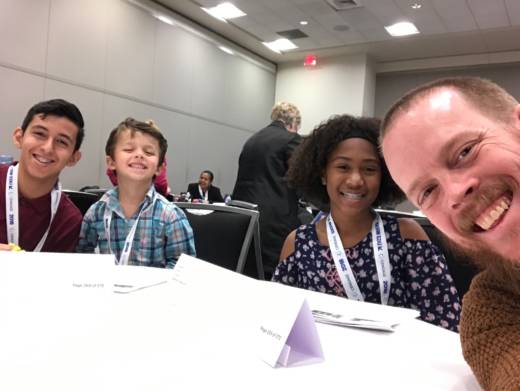Butler emphasizes kindness because he’s troubled by some of the patterns and mindsets he has observed in students over his career.
“I’ve noticed more kids just saying a lot of, ‘I can’t do this,’ ‘I’m not smart enough,’ and just giving up and thinking ‘I can’t do it because I’m not enough.’ That’s where the kindness part comes in.” He added, “If you mess up on a test or if you make a mistake out on the playground, it doesn’t mean you’re a bad person; but you might think you’re a bad person."
As part of a presentation at SXSW EDU, Butler and three of his former students shared what mindfulness looks like at multiple grade levels and why it’s helpful in their age group.
“High school is really stressful,” said Xavier Zamarron, a high school junior. “A lot of things can stack up on you, so it’s nice to take a breath once in a while. And also in high school you kind of feel like a crappy person all the time because of just society, and like you wonder if you’re cool or not, but none of that really matters. When we practice mindfulness, we’re only worried about what we think about ourselves.”
Fifth-grader Addison Green said she thinks if mindfulness was practiced more broadly, it would help kids better resolve social conflicts. She hopes emphasizing kindness would make some of the difficult social aspects of adolescence less painful.
“It’s helping you make better decisions, I think, and making better decisions would mean people wouldn’t get as mad at each other. And they’d treat each other a lot better. Especially in fifth grade because everybody is separating themselves and you lose a lot of friends.”
Academically, Addison said she relies on mindfulness during stressful situations, like when taking high-stakes tests. It helps clarify her thinking. She said that during tests, she ends up thinking about several things at once. Mindfulness exercises help her organize those thoughts so she can focus on one thing.
“I feel a lot more calm and my brain is cleared out. And my memory is a lot better because, like I said, when I do it on a STAAR (State of Texas Assessments of Academic Readiness) test and I’m stuck on a question, I’ll do mindfulness and then I’ll sort of understand what I learned in class.”
First-grader Teo Cardenas, the youngest student in the group, said mindfulness helped when he collided with someone at school and had to go to the hospital. He said he was scared and crying, so he took deep breaths to calm himself down.
MINDFULNESS IN THE CLASSROOM
Butler advises educators interested in practicing mindfulness in their classrooms to develop a regular mindfulness habit for themselves first. That way they’ll feel confident in the practice before teaching it to students. He makes sure to squeeze in five minutes of mindfulness during the time it takes his coffee to steep in the morning. Previously, he used that time to check work email, but has found mindfulness to be a much better way to start the day.
“I have that five minutes and I can just sit down and breathe while the coffee is getting ready,” said Butler. “It doesn’t have to be a one- day silent retreat. Just having a simple tiny teeny practice, every day, that’s awesome just so you know what it’s like. So when you share with your kids, you can empathize, and that makes all the difference in the world.”
As for practicing mindfulness with students, Butler says the exercises are similar across the different age groups, but there are unique challenges to scheduling time at different school levels. Taking five minutes might be easier in elementary school when kids are with the same teacher for the whole day, while the increased number of transitions in middle and high school makes exercises harder to schedule.
Schools with advisory or homeroom are well equipped to practice mindfulness, but Butler said it can also be effective as a transition tool. One middle school science teacher he knows started the school year by introducing a new mindfulness exercise each week, such as breathing, journaling or coloring. Once students were acquainted with a range of mindfulness strategies, the teacher let them pick the one that best fit their needs each week.
Having students lead mindfulness exercises also helped with buy-in, in part because adolescents were given the chance to be in charge.
“The kids who are like, ‘this is dumb,’ when they had a chance to lead or when their friends led, they were into it,” said Butler. “A lot of times kids just want to be heard, even if it’s as simple as pushing play on a mindfulness app.”
STUDENT RECOMMENDATIONS
Student presenters at SXSW EDU shared their recommended tools for practicing mindfulness in the form of books, sites and apps.
Teo, the first-grader, recommends the books "Your Fantastic Elastic Brain" and "Listening to My Body"; the website GoNoodle and Destress Monday, especially the gifs; the apps Stop Breathe & Think Kids and Super Stretch Yoga.

Addison, in fifth grade, recommends the books "What Does It Mean to Be Present?" and "Listening To My Body"; the website GoNoodle and Mind Yeti; the apps Calm and Smiling Mind.
Xavier, the 11th-grader, recommends the books "Cure: A Journey Into Science of Mind Over Body" and "The Happiness Track: How to Apply the Science of Happiness to Accelerate Your Success"; the websites Pocket Mindfulness and UCLA Mindful Awareness Research Center; the apps Calm and Smiling Mind.



